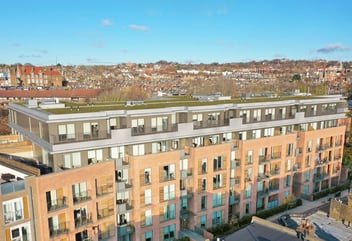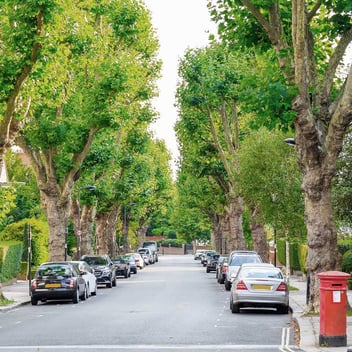A major new report from Zoopla has confirmed what we've been seeing in our deal flow for the past two years: building homes in England has become significantly more difficult. Development costs have risen 17% since 2022, whilst sales values have crawled up just 1%. The result? Just 36% of England is now viable for housing-led development.
Viable: Sales values 5%+ above delivery costs
Marginal: Sales values within +/-5% of delivery costs
Unviable: Sales values 5%+ below delivery costs
For Shojin investors, this matters. It explains why we're bringing fewer development finance opportunities to the platform—and why we're increasingly looking at bridging finance as an attractive alternative.
The viability squeeze: What's changed
The economics of development have been squeezed from multiple directions. Higher interest rates have increased both the cost of development finance and mortgage affordability constraints for end buyers.
Material and labour costs have surged. New regulations—Biodiversity Net Gain, nutrient neutrality requirements, the upcoming Building Safety Levy—have added thousands of pounds per unit in costs that can't easily be recovered through higher prices.
Meanwhile, Help to Buy ended in 2022, removing a crucial demand driver. Housing associations, traditionally bulk purchasers of 20-25% of units on schemes, have pulled back due to their own financial pressures. The Home Builders Federation estimates over 100,000 private homes are currently stalled due to lack of buyers for affordable housing units.
The result is a market where viability is challenged across nearly two-thirds of England. Southern England remains more viable due to higher sales prices, but faces acute affordability constraints that limit buyer demand. In the Midlands and North—where homes are more affordable—sales prices often don't cover development costs.
What this means for our underwriting
At Shojin, we've always prided ourselves on rigorous due diligence. In the current environment, that discipline matters more than ever. Here's what we're focusing on:
- Geography is everything.
We're scrutinising not just whether an area is viable on paper, but whether there's genuine buyer demand at the price points required for viability. The "sweet spot" has narrowed considerably. Schemes in high-value areas must demonstrate realistic sales absorption rates; schemes in affordable areas must show costs have been genuinely stress-tested. - Planning permission is non-negotiable.
With planning approvals down 25% since early 2022, we typically won't consider opportunities without planning already secured. The time and cost to obtain consent has increased, adding risk we're not prepared to pass to investors. - Developer track record has never mattered more.
The developers who succeeded during the Help to Buy era may not be equipped for today's market. We're favouring partners with proven experience navigating challenging conditions, conservative cost management, and strong local market knowledge. - Exit strategies must be diversified.
We're wary of schemes overly reliant on housing association bulk sales or build-to-rent investors. Both sources of demand have become less certain. The best schemes have multiple routes to market and aren't betting everything on one buyer type. - Cost contingencies aren't optional.
With build costs projected to rise another 14% by 2030 and house price growth forecast at just 1-3% annually, there's no room for optimism bias. We're insisting on robust contingencies and, wherever possible, fixed-price build contracts.
We're saying no far more often than we did three years ago. The opportunities we bring to investors have genuinely been stress-tested against the new reality.
Why bridging finance is increasingly attractive
In this environment, bridging finance is emerging as a compelling alternative to development finance for both borrowers and investors.
Bridging loans are shorter-term (typically 6-24 months vs. 18-36 months for development), secured against existing property value rather than speculative end values, and don't carry the construction risk inherent in ground-up development. Crucially, borrowers are not exposed to the same cost inflation and demand uncertainty that plagues full development projects.
For Shojin investors, this translates to a different risk profile: shorter duration, lower exposure to market volatility, and security against tangible assets rather than projected sales values. In a market where development viability is challenged across 64% of the country, that's increasingly appealing.
We're not abandoning development finance—far from it. Well-structured schemes with experienced developers in the right locations still offer attractive returns. But we're being more selective, and we're widening our net to include bridging opportunities that offer compelling risk-adjusted returns without the uncertainties facing new-build projects.
The opportunity hasn't disappeared—It's just narrower
The UK still desperately needs new homes. The government's target of 1.5 million homes over this Parliament is ambitious, and recent planning reforms are genuinely helpful. But supply-side policy alone won't restore viability if costs keep rising faster than prices.
The development finance opportunities that succeed will be those with conservative assumptions, experienced teams, and realistic views of both costs and demand.
At Shojin, our job is to find those opportunities—and to be honest when they're thin on the ground. That's why you might see fewer development finance deals on our platform in 2025, and why bridging finance will play a larger role.
We'd rather bring you fewer, stronger opportunities than chase volume in a market that's fundamentally shifted. When we do present a development finance opportunity, you'll know it's cleared a higher bar than ever before.
FAQs
Based on the September 2025 Zoopla viability report, here are the key questions development finance investors and developers are asking about current market conditions.
How should investors adjust their risk assessment given that 64% of England faces viability challenges?
Investors should weight geography more heavily than ever before. The 64% figure masks significant regional variation—Southern England shows 64% viable markets versus just 10% in Northern England. However, viable southern markets face demand constraints due to affordability, whilst affordable northern markets struggle with costs exceeding sales values.
Focus on schemes in the 36% viable areas with demonstrated buyer demand, planning permission already secured, and experienced developers with conservative cost assumptions. Marginal areas (16% of England) require extra scrutiny of exit strategies and contingency provisions.
What does the 17% cost increase versus 1% price growth mean for project
selection?
This divergence fundamentally changes what makes a viable project. Schemes underwritten with pre-2022 cost assumptions are likely underwater. Only consider projects where developers have: fixed-price build contracts or robust cost contingencies (minimum 10-15%), land acquired at current values rather than 2021-2022 prices, realistic sales pricing at or below 75th percentile for the local market, and programme assumptions of 18-24 months rather than optimistic 12-month timelines.
Build costs are forecast to rise another 14% by 2030 whilst house price growth remains at 1-3% annually, so viability won't self-correct through inflation.
Why is bridging finance becoming more attractive than development finance in this environment?
Bridging finance offers shorter duration (6-24 months versus 18-36 months), security against existing property values rather than projected sales values, and no construction risk exposure to cost inflation.
In a market where development viability is challenged across 64% of England, bridging loans provide lower exposure to the structural headwinds facing new-build projects—rising costs, weak demand, planning delays, and housing association pullback. Returns may be lower than development finance, but so is the risk of cost overruns, programme delays, and sales shortfalls that now plague ground-up development.
How long will these market conditions persist and what could improve viability?
The Zoopla report concludes this is structural rather than cyclical change. Build costs are projected to rise 2.5-3% annually through 2026 and 14% by 2030, whilst house price growth forecasts remain at 1-3%.
Planning reforms may increase supply but won't resolve the cost-price divergence. Government policy focuses on supply-side reforms (planning, devolution) rather than demand-side support, and house price inflation cannot be relied upon to restore viability. Improvement requires either significant cost reduction (unlikely given labour inflation at 7.1% annually) or demand-side intervention (new Help to Buy schemes, institutional buyer guarantees via National Housing Bank).
Expect 18-24 months minimum before meaningful change, possibly longer without policy intervention.
Analysis compiled October 2025 based on Zoopla's 'The Viability Gap' report (September 2025), Home Builders Federation data, ONS construction statistics, and BCIS construction forecasts.



















